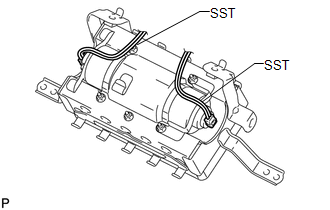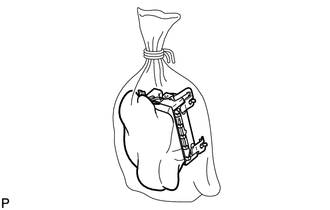Toyota 4Runner: Disposal
DISPOSAL
CAUTION / NOTICE / HINT
CAUTION:
Before performing pre-disposal deployment of any SRS part, review and closely follow all applicable environmental and hazardous material regulations. Pre-disposal deployment may be considered hazardous material treatment.
PROCEDURE
1. PRECAUTION
HINT:
When scrapping a vehicle equipped with the SRS or disposing of the instrument panel passenger airbag, be sure to deploy the airbag first in accordance with the procedure described below. If any abnormality occurs with the airbag deployment, contact the SERVICE DEPT. of TOYOTA MOTOR SALES, U.S.A., INC.
CAUTION:
- Never dispose of an instrument panel passenger airbag that has an unactivated airbag.
- The airbag produces an exploding sound when it is deployed, so perform the operation outdoors and where it will not create a nuisance to nearby residents.
- When deploying the airbag, always use the specified SST (SRS Airbag Deployment Tool). Perform the operation in a place away from electrical noise.
- When deploying the airbag, perform the operation at least 10 m (32.8 ft.) away from the instrument panel passenger airbag.
- The instrument panel passenger airbag becomes extremely hot when the airbag is deployed, so do not touch it for at least 30 minutes after deployment.
- Use gloves and safety glasses when handling an instrument panel passenger airbag with a deployed airbag.
- Do not apply water, etc. to an instrument panel passenger airbag with a deployed airbag.
- Always wash your hands with water after completing the operation.
- An airbag or pretensioner may be activated by static electricity. To prevent this, be sure to touch a metal surface with bare hands to discharge static electricity before performing this procedure.
2. DISPOSE OF INSTRUMENT PANEL PASSENGER AIRBAG ASSEMBLY (WHEN INSTALLED IN VEHICLE)
HINT:
Prepare a battery as the power source to deploy the airbag.
|
(a) Check the function of SST (See page
|
|
(b) Read the precaution (See page .gif) ).
).
(c) Disconnect the cable from the negative (-) battery terminal.
CAUTION:
Wait at least 90 seconds after disconnecting the cable from the negative (-) battery terminal to disable the SRS system.
NOTICE:
When disconnecting the cable, some systems need to be initialized after the cable
is reconnected (See page .gif) ).
).
(d) Remove the instrument panel passenger airbag (See page
.gif) ).
).
(e) Install SST.

(1) Disconnect the connector.
NOTICE:
When handling the airbag connector, take care not to damage the airbag wire harness.
(2) Connect SST connector to the instrument panel wire.
SST: 09082-00700
SST: 09082-00780
NOTICE:
To avoid damaging SST connector and wire harness, do not lock the secondary lock of the twin lock.
(3) Install the instrument panel passenger airbag (See page
.gif) ).
).
|
(4) Move SST at least 10 m (32.8 ft.) away from the vehicle front side window. Text in Illustration
|
|
(5) Maintaining enough clearance for SST wire harness in the front side window, close all doors and windows of the vehicle.
NOTICE:
Take care not to damage SST wire harness.
(6) Connect the red clip of SST to the positive (+) battery terminal and the black clip of SST to the negative (-) battery terminal.
(f) Deploy the airbag.
(1) Check that no one is inside the vehicle or within a 10 m (32.8 ft.) radius of the vehicle.
(2) Press SST activation switch to deploy the airbag.
CAUTION:
- When deploying the airbag, make sure that no one is near the vehicle.
- The instrument panel passenger airbag becomes extremely hot when the airbag is deployed, so do not touch it for at least 30 minutes after deployment.
- Use gloves and safety glasses when handling an instrument panel passenger airbag with a deployed airbag.
- Do not apply water to an instrument panel passenger airbag with a deployed airbag.
- Always wash your hands with water after completing the operation.
HINT:
The airbag is deployed as the LED of SST activation switch comes on.
3. DISPOSE OF INSTRUMENT PANEL PASSENGER AIRBAG ASSEMBLY (WHEN NOT INSTALLED IN VEHICLE)
NOTICE:
Be sure to follow the procedure detailed below when deploying the airbag.
HINT:
Prepare a battery as the power source to deploy the airbag.
|
(a) Check the function of SST (See page
|
|
(b) Remove the instrument panel passenger airbag (See page
.gif) ).
).
CAUTION:
- When removing the instrument panel passenger airbag, wait at least 90 seconds after the ignition switch is turned off and the cable is disconnected from the negative (-) battery terminal before starting work.
- When storing the instrument panel passenger airbag, keep the airbag deployment side facing upward.
|
(c) After connecting SST to each other, connect them to the instrument panel passenger airbag. SST: 09082-00802 09082-10801 09082-30801 |
|
(d) Using a service-purpose wire harness for the vehicle, tie the instrument panel passenger airbag to a tire.
.png) Text in Illustration
Text in Illustration
|
*a |
Wire Harness Diameter |
|
*b |
Stripped Wire Harness Section |
Cross-sectional area of stripped wire harness section:
1.25 mm2 (0.00192 in.2) or more
CAUTION:
If the wire harness is too thin or an alternative object is used to tie the instrument panel passenger airbag, it may be snapped by the shock when the airbag is deployed. Always use a wire harness for vehicle use with a cross-sectional area of at least 1.25 mm2 (0.00192 in.2).
HINT:
To calculate the cross-sectional area of the stripped wire harness section: Cross-sectional area = 3.14 x (Diameter)2 / 4
(1) Position the instrument panel passenger airbag inside a tire with the airbag deployment side facing inside.
 Text in Illustration
Text in Illustration
|
*a |
Width |
*b |
Inner Diameter |
Tire size:
Must exceed the following dimensions
Width
185 mm (7.28 in.)
Inner diameter
360 mm (14.2 in.)
(2) Tie the instrument panel passenger airbag to the tire with several wire harnesses.
CAUTION:
- Make sure that the wire harnesses are tight. If there is slack in the wire harnesses, the instrument panel passenger airbag may become loose due to the shock when the airbag is deployed.
- Always tie the instrument panel passenger airbag with the airbag deployment side facing inside.
NOTICE:
As the tire may be damaged by the airbag deployment, use a tire that you are planning to throw away.
(e) Connect SST connector to the instrument panel passenger airbag.
SST: 09082-00700
(f) Place tires.
 Text in Illustration
Text in Illustration
|
*1 |
Tire (2 or more) |
(1) Place at least 2 tires under the tire which the instrument panel passenger airbag is tied to.
(2) Place at least 2 tires over the tire which the instrument panel passenger airbag is tied to. The top tire should have a disc wheel installed.
NOTICE:
- Do not place SST connector under the tires because it could be damaged.
- As the disc wheel may be damaged by the airbag deployment, use a disc wheel that you are planning to throw away.
- As the tires may be damaged by the airbag deployment, use tires that you are planning to throw away.
|
(3) Tie the tires together with 2 wire harnesses. CAUTION: Make sure that the wire harnesses are tight. Looseness in the wire harnesses results in the tires coming free due to the shock when the airbag is deployed. |
|
|
(g) Connect SST connector. Text in Illustration
NOTICE: To avoid damaging SST connector and wire harness, do not lock the secondary lock of the twin lock. Also, secure some slack for SST wire harness inside the tires. |
|
(h) Deploy the airbag.
(1) Connect the red clip of SST to the positive (+) battery terminal and the black clip of SST to the negative (-) battery terminal.
(2) Check that no one is within a 10 m (32.8 ft.) radius of the tire which the instrument panel passenger airbag is tied to.
(3) Press SST activation switch to deploy the airbag.
CAUTION:
When deploying the airbag, make sure that no one is near the tires.
HINT:
The airbag is deployed as the LED of SST activation switch comes on.
|
(i) Dispose of the instrument panel passenger airbag. CAUTION:
(1) Remove the instrument panel passenger airbag from the tire. (2) Place the instrument panel passenger airbag in a plastic bag, tie it tightly and dispose of it in the same way as other general parts. |
|
 Removal
Removal
REMOVAL
PROCEDURE
1. REMOVE INSTRUMENT PANEL SUB-ASSEMBLY
(a) Remove the instrument panel sub-assembly (See page
).
2. REMOVE NO. 2 INSTRUMENT PANEL WIRE
(a) Detach the clamp.
...
Other materials about Toyota 4Runner:
System Description
SYSTEM DESCRIPTION
1. GENERAL
(a) When the ultrasonic sensors detect any obstacles at the corners and rear
of the vehicle, the system informs the driver of the distance between the sensors
and the obstacles by sounding a buzzer.
2. FUNCTION OF COMPONENT ...
Manual(sos)switch
Components
COMPONENTS
ILLUSTRATION
ILLUSTRATION
Installation
INSTALLATION
PROCEDURE
1. INSTALL TELEPHONE SWITCH ASSEMBLY
(a) Install the telephone switch with the 2 screws.
(b) Connect the connector.
(c) Attach the 8 claws to install the inne ...
0.0281

.png)
.png)

.png)


